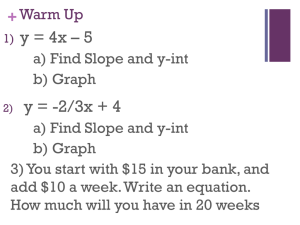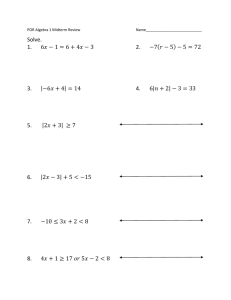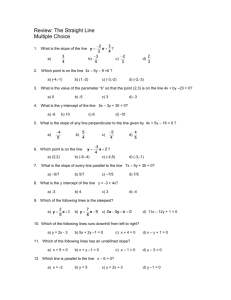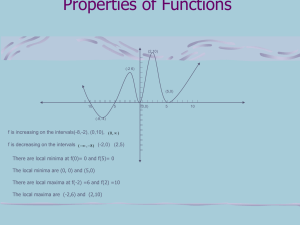Stat 401 A – Homework 11 answers
advertisement
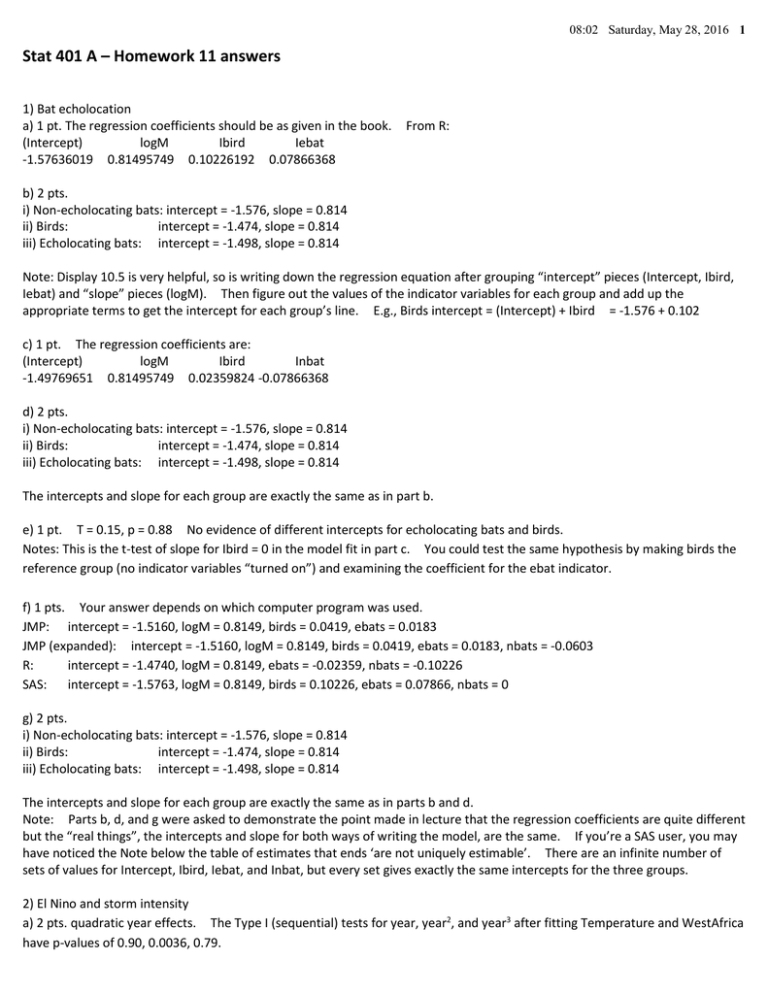
08:02 Saturday, May 28, 2016 1 Stat 401 A – Homework 11 answers 1) Bat echolocation a) 1 pt. The regression coefficients should be as given in the book. (Intercept) logM Ibird Iebat -1.57636019 0.81495749 0.10226192 0.07866368 From R: b) 2 pts. i) Non-echolocating bats: intercept = -1.576, slope = 0.814 ii) Birds: intercept = -1.474, slope = 0.814 iii) Echolocating bats: intercept = -1.498, slope = 0.814 Note: Display 10.5 is very helpful, so is writing down the regression equation after grouping “intercept” pieces (Intercept, Ibird, Iebat) and “slope” pieces (logM). Then figure out the values of the indicator variables for each group and add up the appropriate terms to get the intercept for each group’s line. E.g., Birds intercept = (Intercept) + Ibird = -1.576 + 0.102 c) 1 pt. The regression coefficients are: (Intercept) logM Ibird Inbat -1.49769651 0.81495749 0.02359824 -0.07866368 d) 2 pts. i) Non-echolocating bats: intercept = -1.576, slope = 0.814 ii) Birds: intercept = -1.474, slope = 0.814 iii) Echolocating bats: intercept = -1.498, slope = 0.814 The intercepts and slope for each group are exactly the same as in part b. e) 1 pt. T = 0.15, p = 0.88 No evidence of different intercepts for echolocating bats and birds. Notes: This is the t-test of slope for Ibird = 0 in the model fit in part c. You could test the same hypothesis by making birds the reference group (no indicator variables “turned on”) and examining the coefficient for the ebat indicator. f) 1 pts. Your answer depends on which computer program was used. JMP: intercept = -1.5160, logM = 0.8149, birds = 0.0419, ebats = 0.0183 JMP (expanded): intercept = -1.5160, logM = 0.8149, birds = 0.0419, ebats = 0.0183, nbats = -0.0603 R: intercept = -1.4740, logM = 0.8149, ebats = -0.02359, nbats = -0.10226 SAS: intercept = -1.5763, logM = 0.8149, birds = 0.10226, ebats = 0.07866, nbats = 0 g) 2 pts. i) Non-echolocating bats: intercept = -1.576, slope = 0.814 ii) Birds: intercept = -1.474, slope = 0.814 iii) Echolocating bats: intercept = -1.498, slope = 0.814 The intercepts and slope for each group are exactly the same as in parts b and d. Note: Parts b, d, and g were asked to demonstrate the point made in lecture that the regression coefficients are quite different but the “real things”, the intercepts and slope for both ways of writing the model, are the same. If you’re a SAS user, you may have noticed the Note below the table of estimates that ends ‘are not uniquely estimable’. There are an infinite number of sets of values for Intercept, Ibird, Iebat, and Inbat, but every set gives exactly the same intercepts for the three groups. 2) El Nino and storm intensity a) 2 pts. quadratic year effects. The Type I (sequential) tests for year, year2, and year3 after fitting Temperature and WestAfrica have p-values of 0.90, 0.0036, 0.79. 08:02 Saturday, May 28, 2016 2 Note: The tests associated with these p-values can be interpreted as saying: Adding a quadratic term to a model with Year significantly improves the fit (p = 0.0036 for year2). Adding a cubic term to a model with Year2 does not significantly improve the fit (p = 0.79 for year3). b) 2 pts. Each additional degree of Temperature is associated with a -33.4 unit drop in Storm Intensity, after adjusting for WestAfrica and Year. A 95% confidence interval for this effect is (-47.7, -19.2). [Or, include the se in the statement of association, e.g. is associated with a -33.5 (se = 7.1) unit drop.] Note: I had intended this to be based on the model with WestAfrica and quadratic year (i.e. the result of part a). That was not explicit. Other numbers based on other models are accepted for full credit, so long as they include an estimate of magnitude and its precision. 0.00 0.05 d 0.10 0.15 c) 1 pt. No. The largest Cook’s Distance is less than 0.2, which is much less than the concern level of 1. Note: In case you want see the results, here is the plot: 0 10 20 30 Observation number 40 d) 1 pt. Yes, serious concerns with multicollinearity. The VIF factors for year and year2 are larger than 100000, which certainly exceeds the concern level of 10. Note: Some software would not fit the cubic year model. That’s because the correlations between variables are almost 1. The VIF values for the cubic model exceed 6,000,000,000. Even if software will fit the cubic model, the regression coefficients are not well estimated. e) 1 pt. No concerns about multicollinearity after centering (or approximately centering) year. on how you centered, but they are all less than 2. The exact VIF values depend 08:02 Saturday, May 28, 2016 3 The plots are: 0 3800000 100 year2 3900000 yearc2 200 300 400 500 600 f) 1 pt. 1950 1960 1970 1980 Year -10 -20 1990 0 yearc 20 10 There is a very strong linear dependence between Year and Year2 and almost no linear dependence between centered Year and its square. Copper and Zinc toxicity. The plots are: 0.3 3. 2 pts. Log Protein -0.2 -20 -0.1 -10 Resid 0.0 0.1 Resid 0 10 20 30 0.2 40 Protein 120 140 160 180 Predicted 200 4.7 I don’t see much to choose between these. Note: This is not surprising if you plot Protein against log Protein (see next page). so the plot is nearly linear. That’s why the two residual plots are so similar. 4.8 4.9 5.0 5.1 Predicted 5.2 5.3 The range of Protein values is not very large, 4.7 4.8 logProt 4.9 5.0 5.1 5.2 5.3 08:02 Saturday, May 28, 2016 4 120 140 160 Protein 180 200

